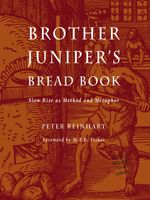Advertisement
Preparation info
- Makes
two
1½ pound loaves - Difficulty
Easy
Appears in
Published 1991
For this loaf, save bread crumbs in a paper sack or make some from leftover heels and ends. Dry them out overnight or in a low oven, toasting them until the moisture is gone. Use a mixture of crumbs from different breads for a unique flavor.
Ingredients
8 cups 2 cups
Method
To Mix and Knead
Mix all the dry ingredients including either yeast in a bowl, then add the water, reserving a little for adjustments during kneading. Turn the dough onto a floured surface and knead it for between 10 and 12 minutes. The dough will have a coarse look because of the crumbs but will be cohesive, stretchy, tacky but not sticky, and resilient. (In all of the recipes I use


